Despite there being greater attention given to gender equality in the workplace in recent years, the sad truth is that gender bias continues to influence hiring decisions globally.
According to a UN report that collected data from 75 countries, 90% of men and women hold some bias against women — with almost half of the respondents believing that men make stronger political leaders and business executives.
Women continue to face adversity at every stage of the employment cycle, from the moment they click on a job post to their opportunities for career progression. So, the question must be asked: Where is gender discrimination showing up in the recruitment process, and how can organizations take a pragmatic approach to gender equity in the workplace?
In this article, we’ll discuss what gender discrimination is, how it currently looks in the workplace, four ways you’re likely perpetuating gender discrimination without realizing it, and how you can rectify it.
What is gender discrimination?
Gender discrimination, particularly in employment, is when a candidate or employee is treated differently or less favorably than someone from the opposite sex, whether they’re applying for a job or an existing employee wishing to advance. Generally, gender discrimination occurs when employers or colleagues make assumptions about the capabilities of workers or applicants based purely on their gender identity or sexual orientation.
It’s important to note that gender discrimination is illegal according to federal law. As part of the Civil Rights Act of 1964, it is illegal for employers to discriminate against job applicants or employees based on sex, race, color, religion, or ethnicity.
Gender discrimination can present itself in many areas of the employment cycle, including:
- Not hiring a specific gender due to stereotypes and unconscious bias, i.e., not hiring a female applicant because you believe men are stronger leaders, more analytical, and more confident.
- Not paying people with identical skills in the same role the same salary because of their sexual orientation or gender identity.
- Not providing all genders with the same opportunities to develop and progress — i.e., training, mentoring, or promotional advances.
- Delegating tasks based on a person’s gender and perceived strengths.
- Verbal, physical, or sexual harassment.
- Hostile remarks made about people of a certain sexual orientation or gender identity.
- Being held to different standards because of someone’s gender or sexual orientation.
- Being rejected for a position or forced to go on leave because someone is pregnant.
What does gender discrimination currently look like in the employment cycle?
Gender discrimination is still incredibly prevalent across various aspects of a person’s career — from the initial screening process to career development and salary negotiations.
The following statistics create a frightening portrayal of the reality of gender discrimination in recruitment:
- Male and female managers are twice as likely to hire a male applicant over a female, according to the Proceedings of the National Academy of Sciences.
- According to Harvard Business Review, women are 79 times more likely to be hired when at least two female applicants are on the shortlist.
- Women are 25-46% more likely to get the job when there are blind interviews or auditions.
- According to Pew Research Center, about four in 10 female employees admit they’ve experienced gender discrimination at work.
- 25% of women say they’ve earned less than a male employee for doing the same job.
- Only 5% of men say they earned less than their female counterparts. That’s one-in-twenty men.
- According to Pew Research Center, women may never make up half the workforce. Instead, their involvement is estimated to peak in 2025 at 47.1%. In fact, by 2060, it’s predicted that women’s contributions will drop to 46.3%.
- According to the 2020 Global Gender Gap Report, a 31.4% average gender gap remains to be closed globally.
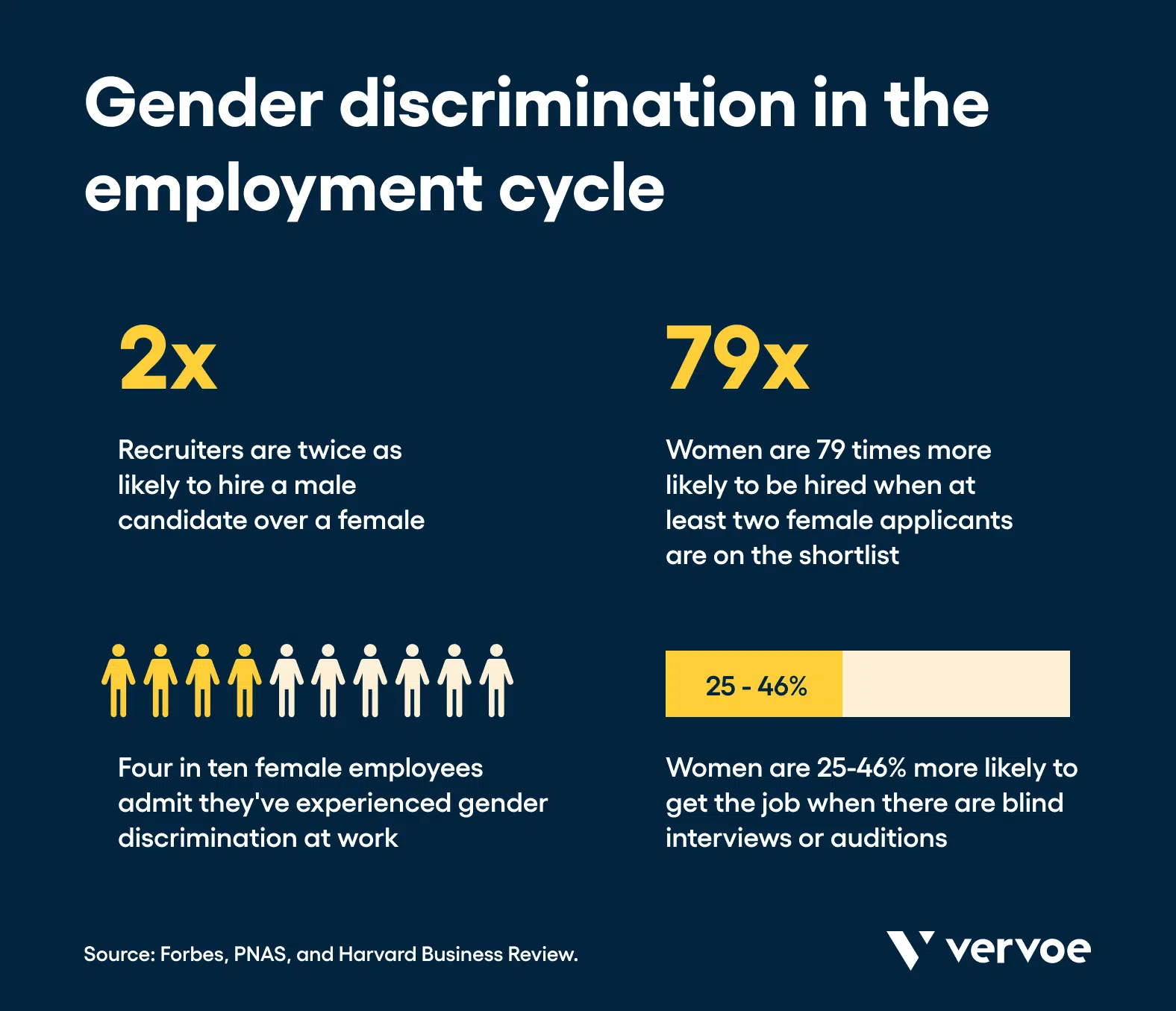
[Read more: The Top 5 Benefits of Gender Diversity to Create a Better Workplace]
4 ways you’re perpetuating gender discrimination in your hiring process — and how to remove it
1. Your job posts are gender-skewed
Gender discrimination in job posts
Contrary to popular belief, many cases of gender bias start at the beginning of the recruitment process before organizations have even had the chance to meet prospective employees.
Your job titles, job description language, and role requirements all influence whether or not a candidate self-selects in or out of the hiring process.
[Read more: 4 Tips to Eliminate Job Description Gender Bias and Improve Your Hiring]
According to Appcast, job posts containing gender-neutral language result in 67.5% more applicants at a 68.5% lower cost per application than job descriptions that use both female and male-skewed words.
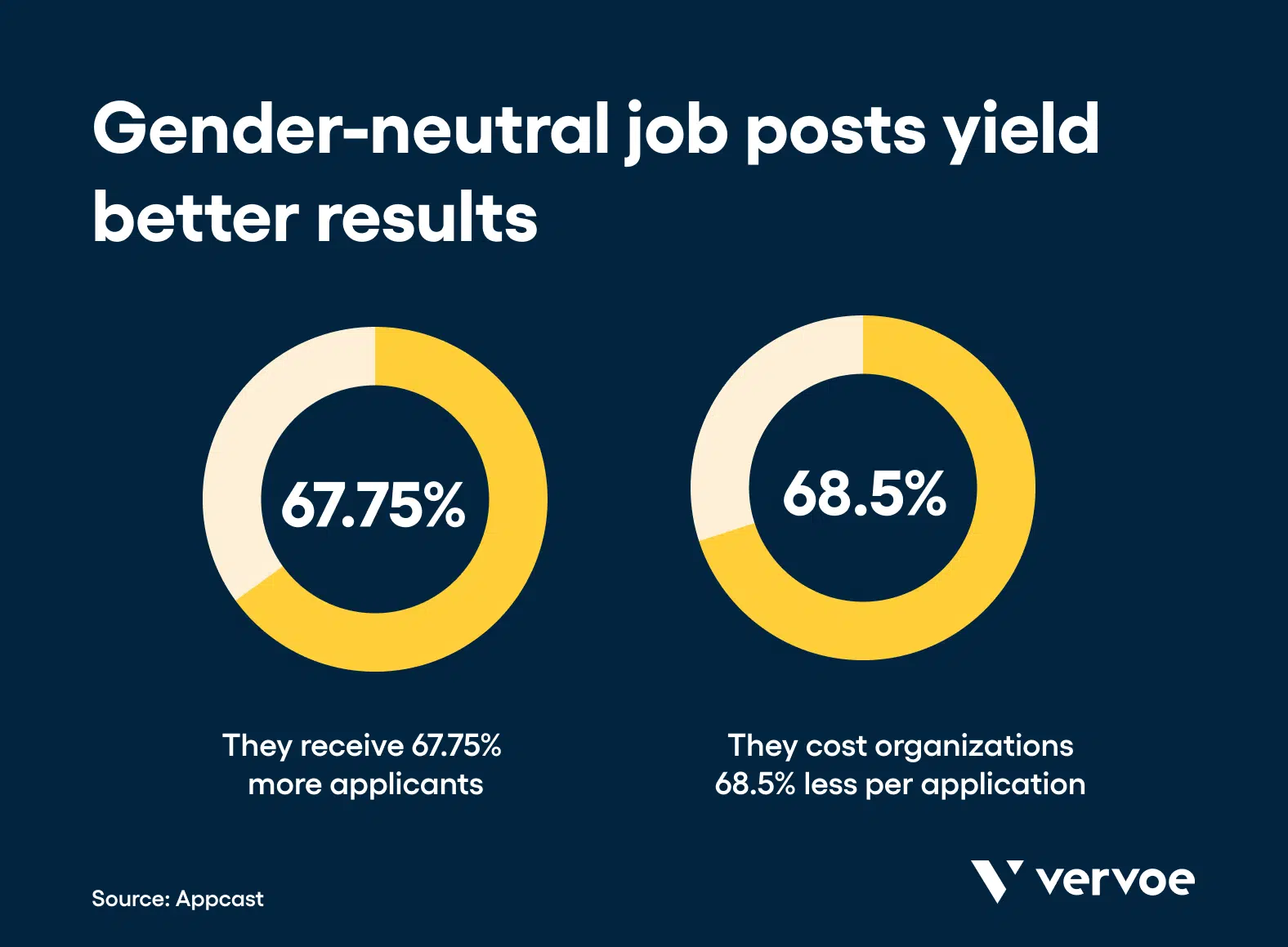
Despite these findings, job posts are still heavily skewed towards male applicants, significantly impacting how female job seekers interact with job postings.
Let’s delve a little deeper into each of these points:
Job titles
Gender-skewed job titles are still very much present in the recruitment world. And unfortunately, this can have a detrimental impact on an organization’s talent pool, workplace diversity, and bottom-line profitability.
Where gender does not influence the role’s success, the job title should be an inclusive, gender-neutral, and accurate representation of your position.
For example, job titles such as “fireman,” “handyman,” and “waitress” all have an assigned gender in their title. This alone can automatically deter people from considering your role, drastically reducing the size of your talent pool and the quality of your talent.
Consider the following alternatives for common gender-skewed job titles:
| Gender-skewed job title | Gender-neutral job title |
| Fireman Handyman Salesman Congressman Waitress Barmaid | Firefighter Maintenance Person Salesperson Member of Congress Server Bartender |
Job description
A job description is your first opportunity to market an open role to prospective employees. It demonstrates your company culture, showcases your values, and influences who applies.
However, job posts are predominantly more appealing to male job seekers due to the frequent use of masuline language. As a result, female applicants are more likely to assume they aren’t the ideal candidate, and opt out before learning more about the role.
According to an Appcast study that analyzed the job descriptions of 17 different industries, 13 contained predominantly male-coded language, including:
The prominence of male-coded language in job descriptions
| Job function | % of masculine language |
| Security | 75% |
| Construction | 66% |
| IT | 66% |
| Travel | 63% |
| Sales | 62% |
| Healthcare | 60% |
| Property | 60% |
| Consulting | 57% |
| Legal | 57% |
| Insurance | 55% |
| Science | 55% |
| Education | 51% |
| Human resources | 51% |
So, what exactly is male and female-coded language? Researchers at Duke University and the University of Waterloo analyzed several job posts. They concluded that the following words are heavily gendered:
- Masculine-coded words: adventurous, aggressive, ambitious, challenge, champion, courageous, fearless, independent, and self-sufficient.
- Feminine-coded words: compassionate, considerate, honest, enthusiastic, empathetic, kind, nurturing, sensitive, and sympathetic.
Role requirements
When considering how female job seekers interact with job posts, it paints a clear picture that urges organizations to rethink their language and requirements. According to LinkedIn’s Gender Insights Report:
- Women are 16% less likely than men to apply for a job after viewing it.
- Women apply to 20% fewer jobs than men.
Wondering why? According to a Hewlett Packard internal report, men are confident in applying for a role if they tick 60% of the criteria. In contrast, women will often eliminate themselves from the process if they don’t meet 100% of the job requirements.
How to remove gender bias from job posts
1. Remove gendered words
Be intentional with your language in job descriptions. Educate your organization on the importance of inclusive language, and ensure your team understands the difference between gendered and neutral words.
When writing your job title, ask yourself:
- Does it reflect what the role entails?
- Does it contain heavily gender-skewed words? For example, instead of saying “policeman” or “weatherman,” say “police officer” or “weather anchor.”
- Have you educated yourself on subtle language that could deter certain genders from applying? For example, according to Glassdoor, words such as “rockstar,” “superhero,” “guru,” and “ninja” have a masculine undertone and should be avoided in your job titles.
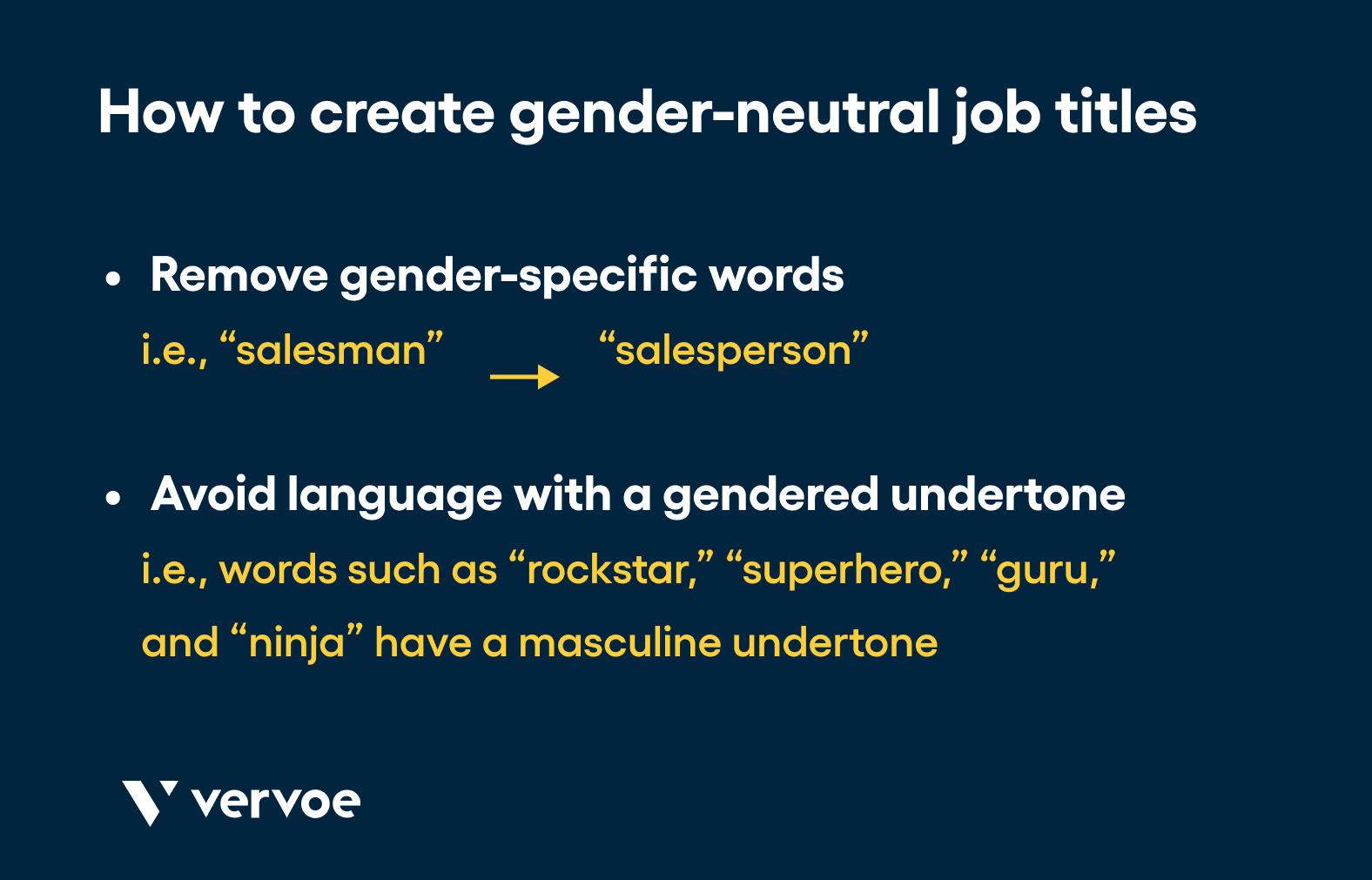
2. Get a second opinion
One effective way to ensure your language is consistently inclusive in your job descriptions is to use an augmented writing tool like Textio. Textio is an AI writing tool that analyzes your job descriptions and provides a score and suggestions based on how inclusive and engaging your language is.
1. Remove unnecessary job requirements
Consider what requirements are critical to the role’s success and remove anything that may act as a deterrent to certain genders.
For example, women have had less presence in positions of seniority throughout history. If you require senior leadership experience, are you unnecessarily prompting female candidates to self-eliminate from the process?
2. You’re still using traditional recruitment practices to assess candidates
Gender discrimination in candidate screening and assessments
When it comes to validating and assessing candidates’ suitability for the role, the unfortunate reality is that traditional methods are riddled with unconscious bias. And at this stage of the recruitment process, women are already significantly disadvantaged — experiencing far greater scrutiny than men.
[Read more: 8 Inclusive Hiring Practices You Need To Adopt Today]
Consider the following research findings to understand the reality of gender bias in the screening process:
- A Yale University study asked 127 university science faculty members to score and select a fictional job application of a prospective lab manager. The applications were randomly assigned feminine or masculine names. Despite the applications being identical, the male and female science faculty members believed the male candidate was more competent than the female. The cherry on top? The evaluators also suggested higher starting salaries for the male candidate.
- 238 US academic psychologists were asked to evaluate one of two identical resumes, one belonging to a female and the other to a male. While evaluators admit to preferring the female candidate over the male, most recommended the male applicant for the role. More so, evaluators were four times more likely to question the female’s application, wanting further validation of her accomplishments.
- A US experiment asked 93 participants to review male and female applicants for a fictional construction manager position. Before genders were disclosed, evaluators considered education more important than prior work experience. Yet, when researchers revealed the candidates’ genders, participants switched to favoring prior work experience over education when the more educated applicants were females.
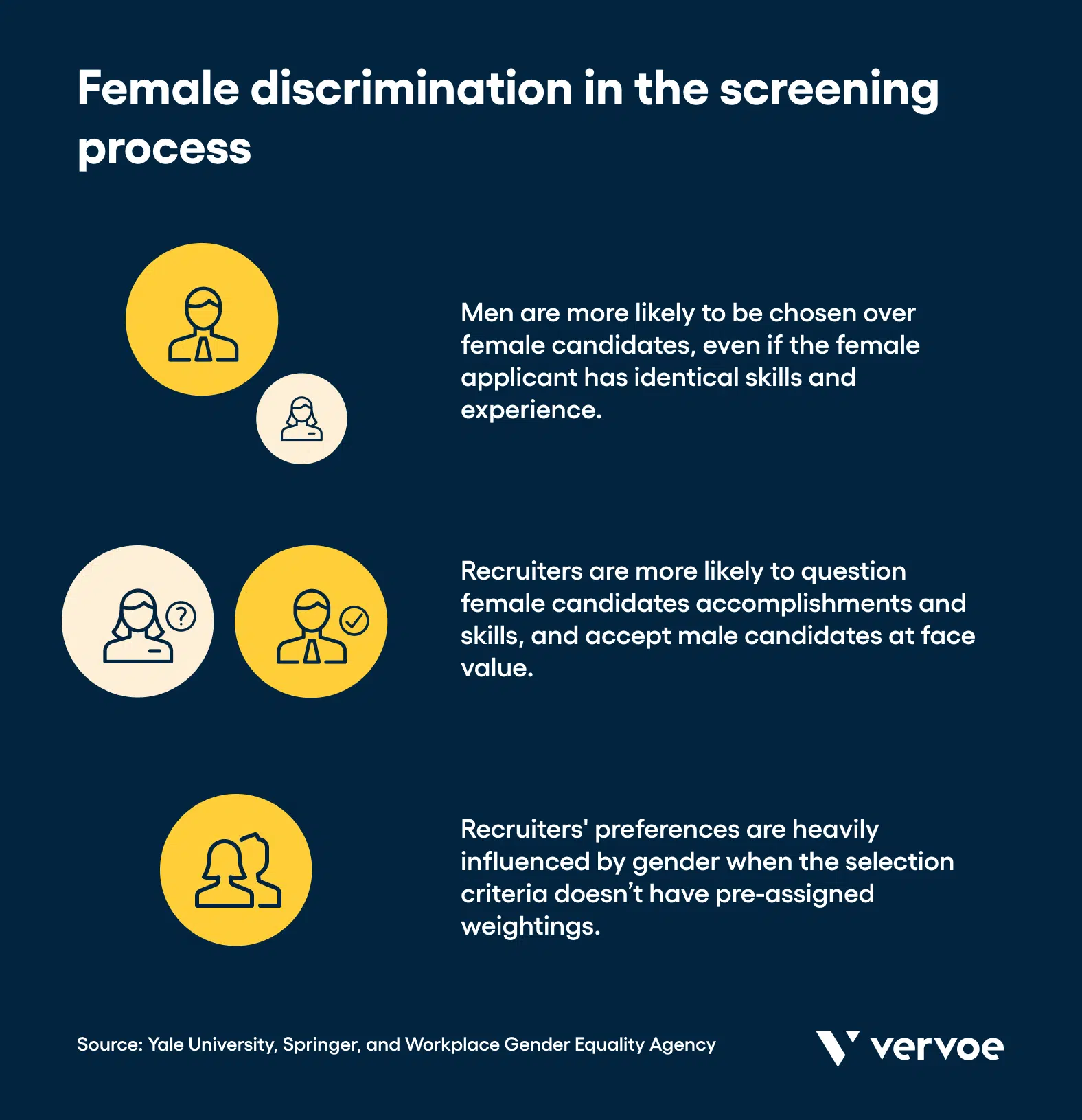
How to remove gender bias from your screening process
It’s simple: trade in the archaic traditional screening processes — including phone screens, CV screening, and panel interviews — for a skills-based approach powered by an AI-powered platform, like Vervoe.
Vervoe’s skills assessments use machine learning AI to test, grade, and rank candidates according to how their hard and soft skills align with the role. By assessing candidates based on their skills and removing human bias from the process, Vervoe helps organizations focus on the factors that influence a candidate’s success.
[Read more: 3 Ways Skills-Based Hiring Helps Combat The Gender Gap]
Here’s how Vervoe’s skills-based hiring can help remove gender discrimination from hiring:
AI automation reduces bias
Vervoe uses AI grading to assess candidates’ suitability for the role, removing the human biases often present when evaluating candidates.
By placing a Vervoe skills assessment at the top of your hiring funnel, organizations can remove the need to manually screen candidates, gaining access to a broader talent pool to ensure no great candidates slip through the cracks. Grading and ranking candidates without human intervention removes the unconscious biases that influence decisions and eliminate potentially great talent. And as we know, this is often women.
Candidates are judged based on their skills rather than gender stereotypes
Vervoe’s AI-powered skills-based testing creates a shortlist of candidates based on how their soft and hard skills align with the role’s requirements. Vervoe’s AI only looks at factors critical to the role’s success, meaning things like gender, education, experience, and age won’t have an impact.
Skills testing helps candidates prove what their resumes can’t
In traditional screening processes, recruiters are more likely to have preconceived ideas of candidates’ suitability for the role based on their resume and initial phone interview. Skills-based testing allows all applicants to prove and validate their skill set without being automatically eliminated for factors that don’t determine their success.
Through Vervoe’s skills-based assessments, applicants have a chance to demonstrate their capabilities through a variety of question types, including multiple-choice, text-based, video, audio, spreadsheet, simulations, and more. This leaves little room for candidates to be judged on their gender, ensuring their skills lead the way.
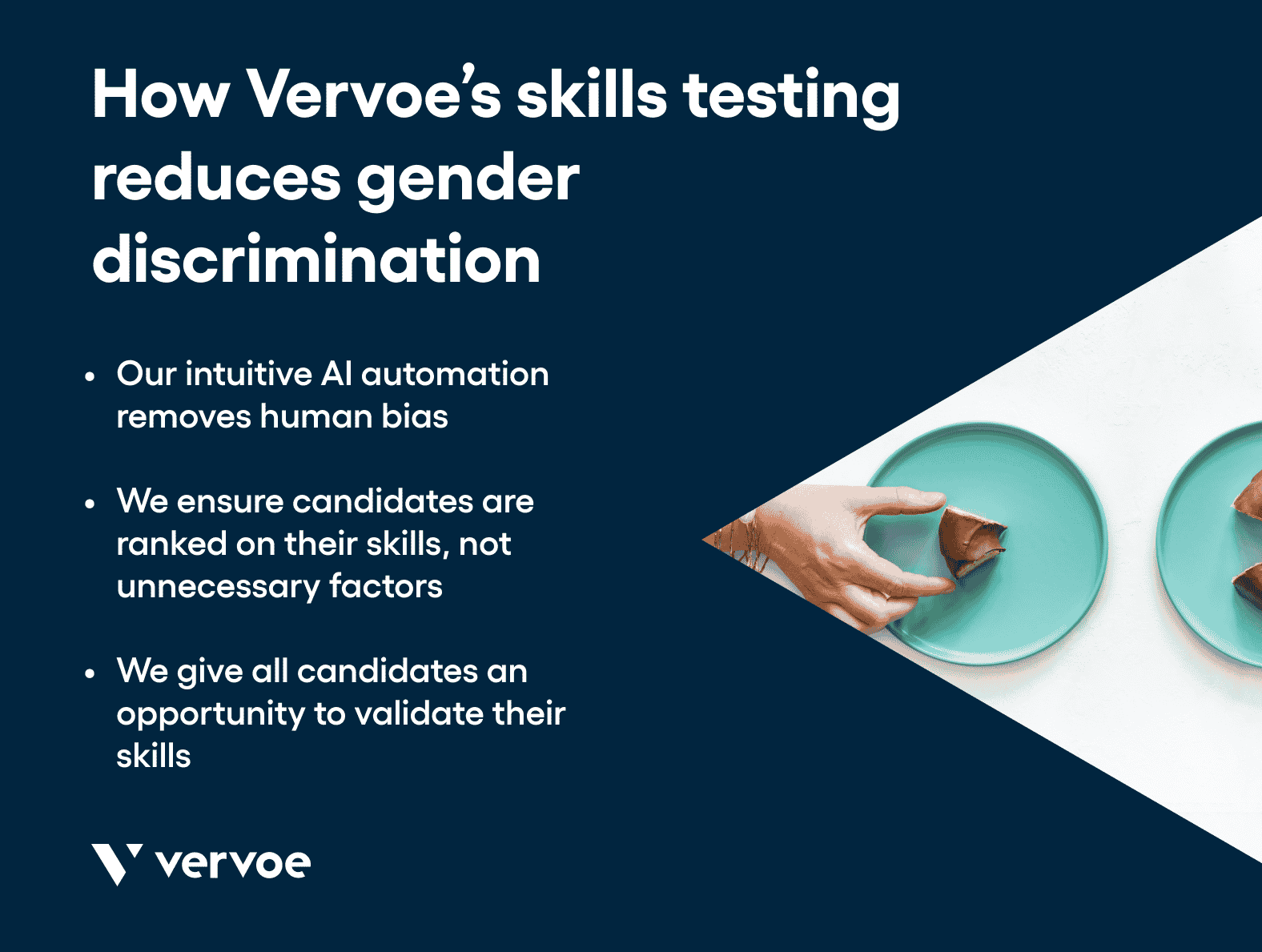
3. Your talent acquisition team lacks diversity
Gender discrimination in talent acquisiton teams
While findings on this topic aren’t conclusive, there’s compelling evidence suggesting that a diverse recruitment team helps reduce gender bias in hiring. It certainly makes sense, in theory, to assume that a gender-balanced hiring board will bring a range of perspectives and beliefs when reviewing candidates. Why? Because diverse hiring starts with diverse talent acquisition teams.
It’s important to note that relying on this solely to reduce gender bias in the hiring process will have minimal impact. However, when used alongside other practical tools, such as AI-powered skills assessments and structured interviews, it helps to create an even fairer hiring process that gives all candidates a chance.
Consider the following findings from an SHRM study of 831 recruiters in the US:
- Male recruiters paid closer attention to appearance, personal style, and enthusiasm during screenings.
- Male recruiters were more likely than female counterparts to look at candidates’ photos before meeting them, admitting the picture influenced whether or not they wanted to advance the candidate to the next stage.
- Female recruiters were more likely to emphasize a candidate’s formal qualifications and references.
What does this suggest? Humans are inherently biased, and there’s very little we can do to remove this from the recruitment equation entirely. However, building a talent acquisition team with various lived experiences and beliefs may help organizations bring multiple perspectives and considerations to the hiring process, ensuring candidates are hired based on merit.
How to reduce gender bias in your talent acquisition team
This one’s a given: add more diversity to your recruitment team to offer a variety of perspectives.
However, this doesn’t just mean equal representation of males and females. It means considering the rich perspectives and experiences of all types of diversity — including racial, cultural, age, sexual orientation, disability, and more.
However, it’s not enough to simply hire a diverse talent acquisition team and assume the rest of the process will fix itself. It’s about leveraging the perspectives that come with diversity while also investing in equitable recruitment practices. For example, once you’ve built a diverse hiring board, consider the following:
- Do they have adequate knowledge and training in diversity hiring?
- Is your team aware of their personal unconscious bias and how this affects the recruitment process?
- Do they require structured interview training?
4. Your interview process is unstructured
Gender discrimination in the interview process
According to a meta-analysis that evaluated 85 years of research to determine how well assessments predict job performance, the researchers found that an unstructured interview only explains 14% of an employee’s performance.
An unstructured interview is non-directive and free-flowing, almost mimicking the relaxed and informal nature of an everyday conversation. Generally, an unstructured interview is open-ended, with the flow of the conversation dictated by the respondent’s answers. As such, this interview style has no set questions or order.
While an unstructured interview may offer a more relaxed and comfortable environment for candidates, the lack of structure can also be an incubator for unconscious bias to influence hiring decisions. According to a LinkedIn study, 42% of recruiters believe interviewer bias is a challenge in traditional interview practices.
Wondering why? When applicants are given different interview processes, they are graded on different criteria, meaning there’s no objective evaluation of who is most suitable for the role. Unconscious bias can impair the recruiter’s judgment, turning a fair, objective, and accurate assessment into one based entirely on assumptions, stereotypes, and prejudices.
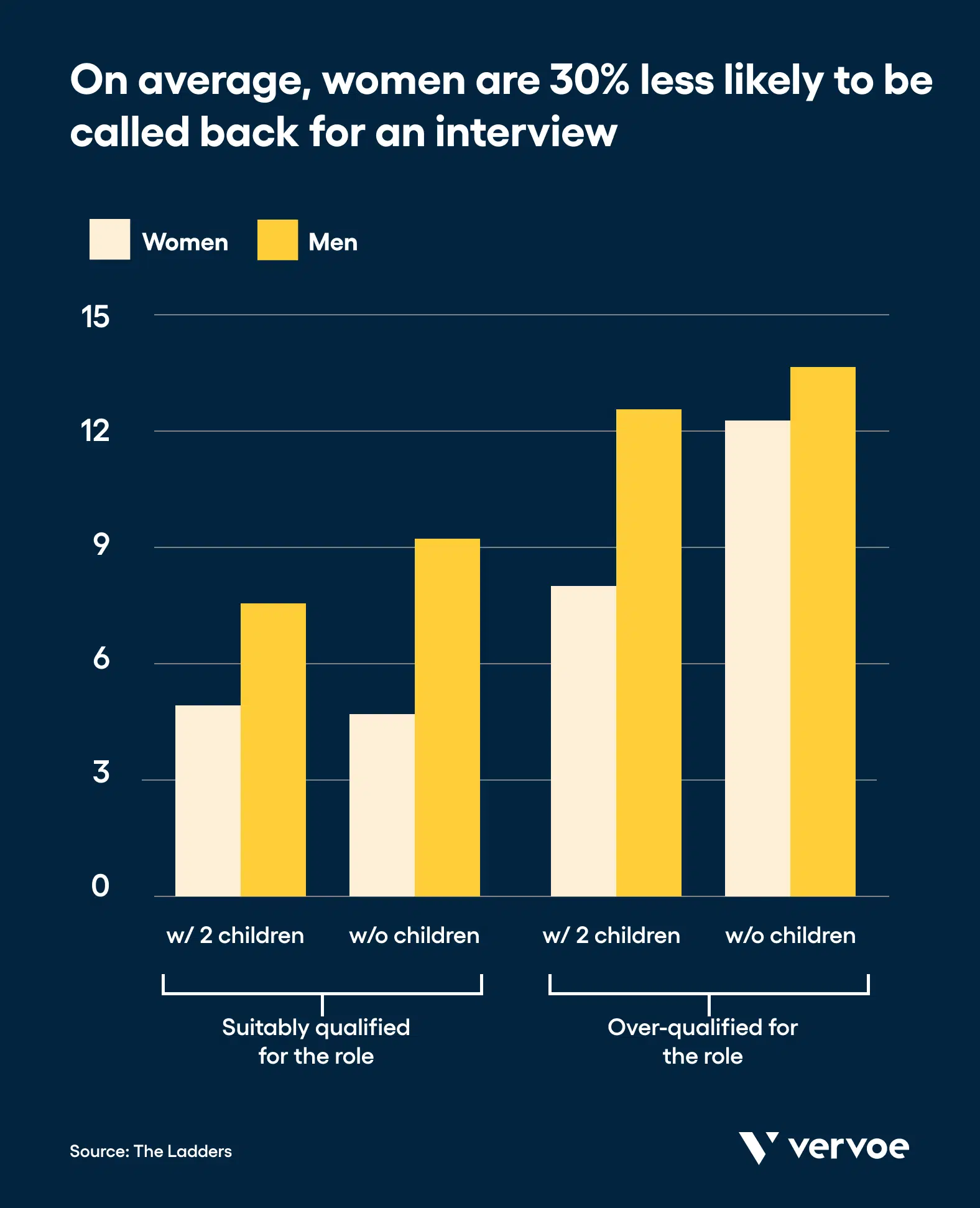
Gender bias presents itself in many ways in the interview process, especially when consistency and structure are lacking. Consider the following findings:
- According to a Pompeu Fabra University study, women are 30% less likely to be selected for a job interview when compared to a man with similar qualifications and experience. This number increases to 35.9% for female applicants with children.
- A UK YouGov survey of 1,106 senior leaders found that one-third of respondents who work for private companies believe it’s reasonable to ask female candidates about their plans to have children in the recruitment process. 59% feel women should have to disclose if they’re pregnant in an interview, and 46% believe it’s fair to ask a woman about her parental status.
- A Journal of Social Sciences study revealed that women are more likely than men to be interrupted during interviews due to follow-up questions.
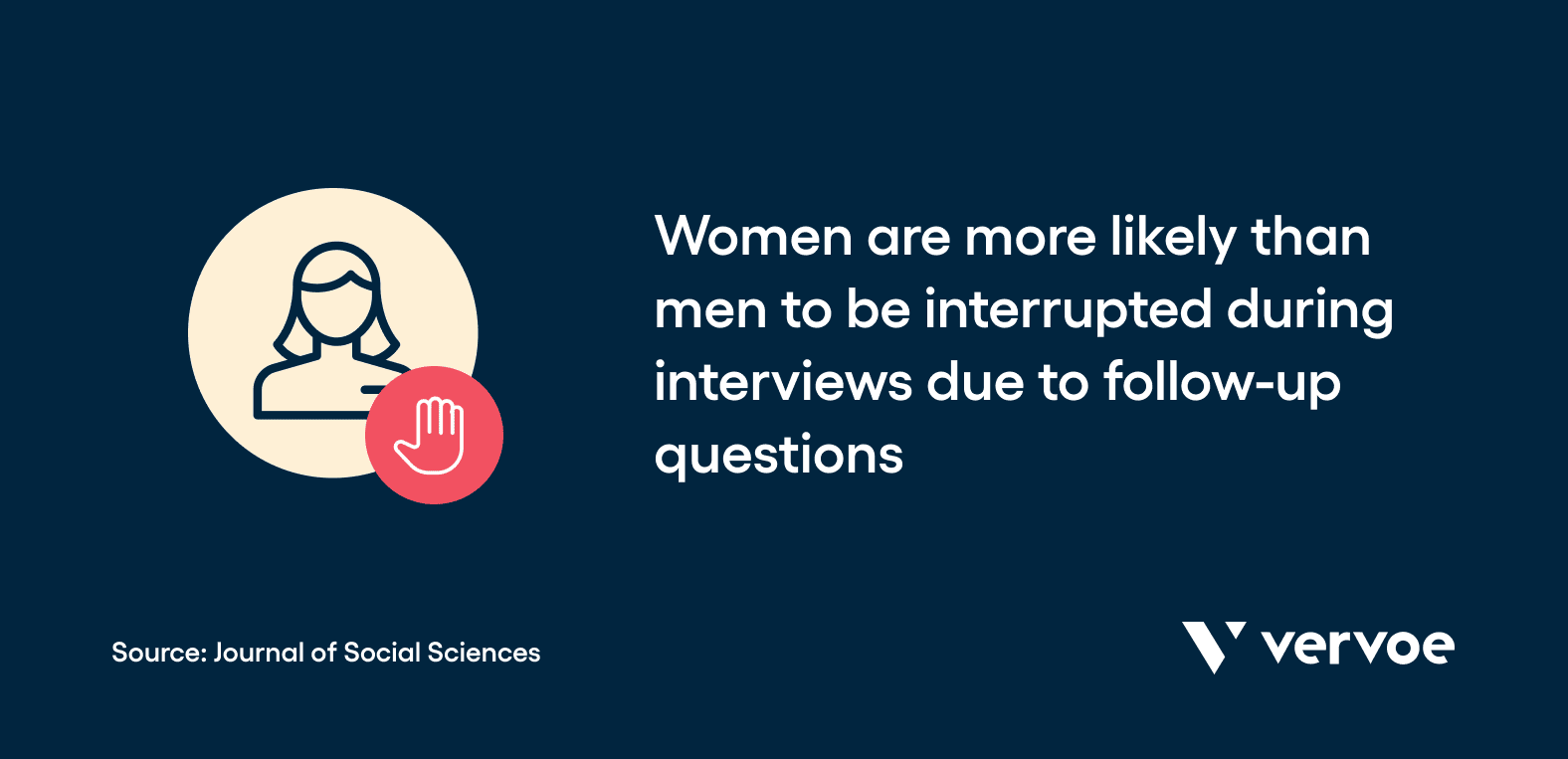
How to remove gender discrimination from your interview process
Research suggests that structured interviews are 81% more accurate than unstructured alternatives. Adopting a structured approach helps organizations reduce gender-influenced decisions and creates an even playing field for candidates.
According to Schmidt and Hunter’s meta-analysis, work sample tests (i.e., a Vervoe skills assessment) and structured interviews are the most effective predictors of job performance.
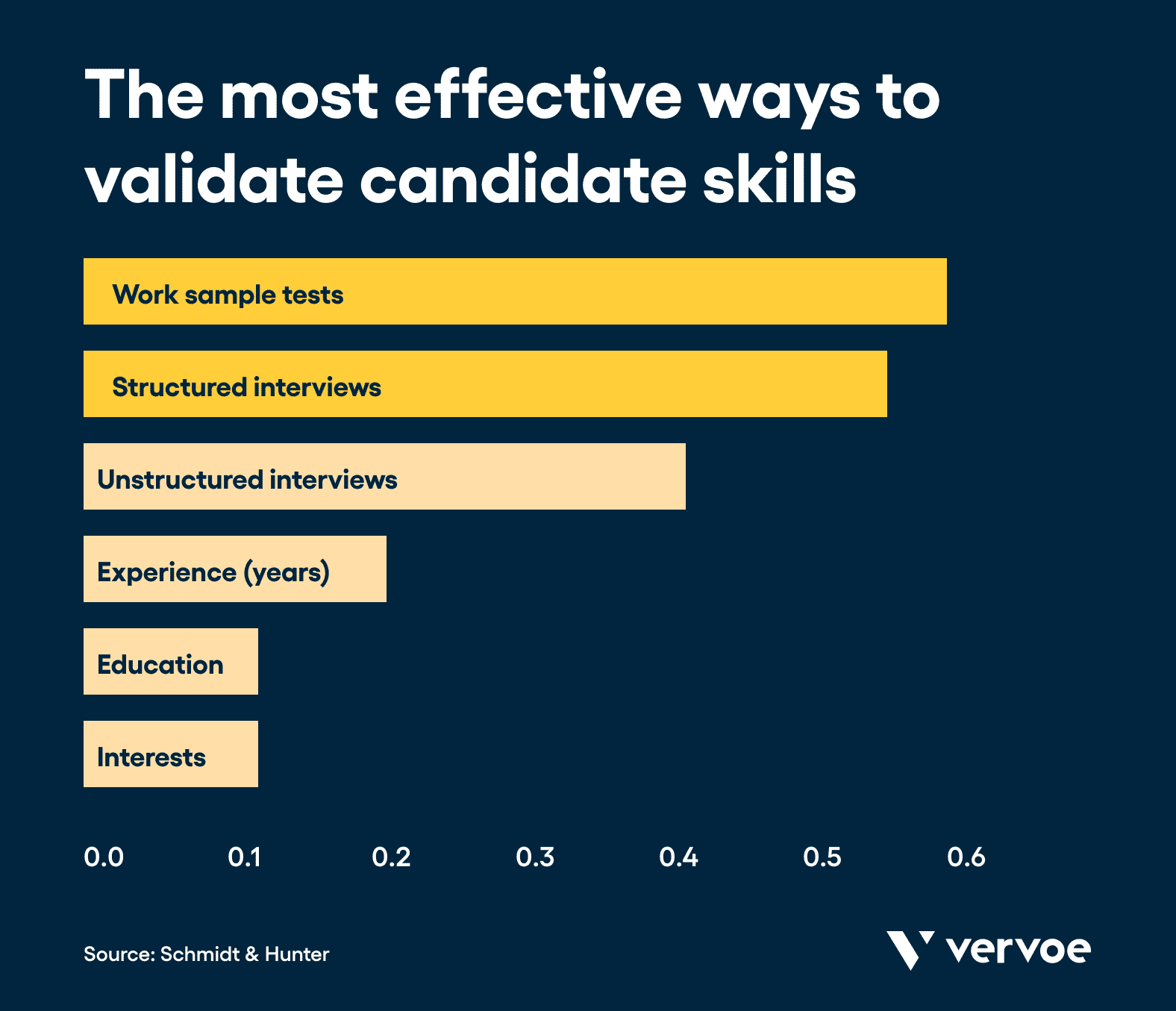
A structured interview means asking all candidates a set list of questions in the same order and grading all candidates objectively against the same criteria with a scorecard.
Here are a few tips to help standardize your interview process:
1. Be intentional with how you phrase your questions to gain greater insight
Write down the skills critical to the role’s success, and ask questions that help you gain more insight into the core competencies. It’s important to be direct, yet broad enough to give the candidate freedom to demonstrate their hard and soft skills.
For example, according to Medium, instead of asking a candidate to tell you about their skill in XYZ at job ABC, ask the candidate what positions, both professional and non-professional, did they utilize skill XYZ, and what were some of their greatest challenges they had to overcome.
2. Ensure your questions are focused on specific skills and cultural fit
The interview phase is your opportunity to understand the candidate’s preferred working style, how they’ll work with your team, and if they have what it takes to succeed in the role. Consider the following interview questions:
Structured interview questions
| Job-specific questions | Cultural-specific questions |
| Explain your professional and personal experience using [software, equipment, tools, skill] | How do you like to be managed? Can you please provide an example of how this might look in practice? |
| What skills are most important for a candidate to succeed in this role, and why? | What encouraged you to apply for this role? |
| What is your approach to keeping your skills up to date? | How do you maintain positive working relationships and handle conflict? Please provide an example |
3. Use a standardized scorecard to assess all candidates’ responses
A scorecard is a form that each interview fills out for each candidate to help evaluate candidates objectively.
While a scorecard will generally vary across roles and companies, an example of a scorecard is a list of criteria with three columns next to each that represent good, average, and bad answers. At the end of the interview process, interviewers’ scorecards are collated and an evaluation is made based on the average score.
Final thoughts
The harsh reality? In 2022, women are still outnumbered, outranked, and out-earned by males in the workforce. The even more alarming truth is that this sentiment is evident throughout the entire employment cycle — from the top to the very bottom, before candidates even manage to get a foot in the door.
While there are larger issues regarding gender workplace discrimination that need to be addressed at all stages of employment, talent acquisition teams play an important role in influencing change at the beginning of the hiring funnel.
By reevaluating job descriptions, using objective screening and assessment tools like Vervoe to verify candidate skills, building a more diverse recruitment team, and implementing a structured interview process, it allows for a fairer and more inclusive recruitment process that favors gender equality. And it requires very little effort to get started.
To find out more about how Vervoe’s AI-powered skills assessments can help minimize bias in your hiring process, book a demo today, browse our assessment library for ready-made options, or start creating your own assessment today.




















